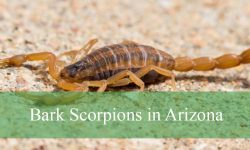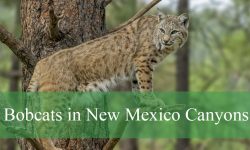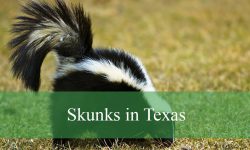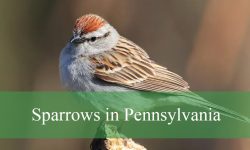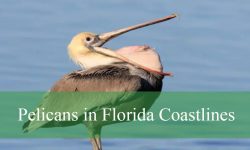Georgia hosts diverse caterpillar species, the larvae of moths and butterflies. While they transform into beautiful winged creatures, some caterpillars in the state are poisonous, causing skin irritations or allergic reactions. It’s crucial to recognize and respect these inhabitants and their potential hazards. In this article, we’ll explore 23 caterpillars found in Georgia, including some venomous species.
Does Georgia Have Poisonous Caterpillars?
Yes, Georgia is home to several species of caterpillars that possess venomous spines or hairs, causing skin irritation or allergic reactions in some individuals. Some notable examples include the Puss Caterpillar and the Io Moth Caterpillar. It’s essential to exercise caution and avoid direct contact with unfamiliar caterpillars in the region to prevent any potential harm.
The most common Caterpillars in Georgia with pictures and identification
1. Giant Leopard Moth Caterpillar (Hypercompe scribonia)

Fully grown Giant Leopard Moth Caterpillars display a bold black color with red gaps between segments, donning firm black hairs emerging from brownish nodules. They feast on a variety of leaves, including those from dandelions, violets, honeysuckle, and citrus plants. Despite their intimidating look, they are completely harmless.
2. Stinging Rose Caterpillar (Parasa indetermina)
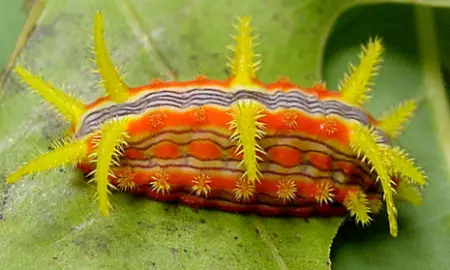
Parasa indetermina (the Stinging Rose Caterpillar), has vivid colors of orange, purple, red, and yellow that give it an almost artistic aspect. Usually, it eats the leaves of trees such as hickory, dogwood, and apples. It is notable for having seven pairs of horn-like spines that are filled with something vexing. When a material comes into accidental touch with human skin, the spine may break and emit a severe sting.
3. Spun Glass Slug Caterpillar (Isochaetes beutenmuelleri)
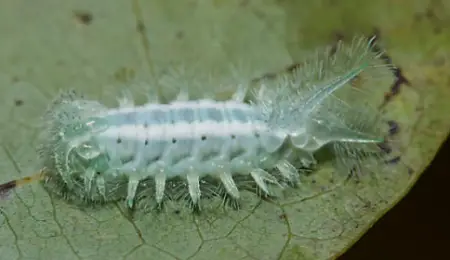
When it is in its larval form, the Spun Glass Slug Caterpillar (Isochaetes beutenmuelleri) resembles fragile spun glass with needle-like spines that give off a translucent shine. Its primary food source is swamp oak trees. This caterpillar has poisonous spiky hairs that can irritate skin when touched, so exercise caution when working with it.
4. Tiger Moth Caterpillar (Arctia caja)
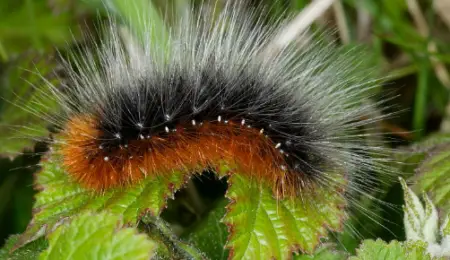
The large black body of the Tiger Moth Caterpillar (Arctia caja) is adorned with a thick covering of ginger and black hairs, making it stand out. The adult moths only consume the nectar of flowers, but they also eat a variety of wild herbs and greens. It is advisable to use caution because these caterpillars have strong poisons that can lead to nausea, serious digestive issues, and in severe circumstances, even death. Because of their toxicity, they are occasionally used in agriculture to control pests.
5. White Furucla Moth Caterpillar (Furcula borealis)

The characteristic hair tuft located between its head and upper torso allows people to identify the White Furcula Moth Caterpillar (Furcula borealis), which is mostly active at night. Its body is either green or yellow, and in the middle is a dark brown diamond-shaped mark that extends to a thin, split tail.
Usually, they eat willow, poplar, and cherry leaves. The white furcula moth is harmless and does not represent a risk to people, despite their unusual appearance.
6. Rosy Maple Moth Caterpillar (Dryocampa rubicunda)
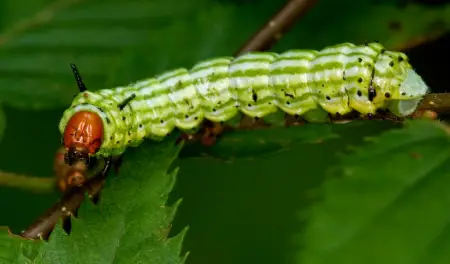
The green-striped mapleworm, or Rosy maple moth caterpillar (Dryocampa rubicunda), has five larval phases. At first, it has a dark head and a pale yellow-green body with faint green lines. Mostly, they eat the leaves of maple, oak, and beech trees. In adulthood, they stop eating. It’s best to avoid the caterpillars as they can sting you severely if you come in contact with them.
7. Snowberry Clearwing Caterpillar (Hemaris diffinis)

The Snowberry Clearwing Caterpillar (Hemaris diffinis) has black dots close to its breathing holes and a vivid green color overall. It displays a black tail spike with a yellow base and a yellow ring behind its head. Buck brush, snowberries, horse gentian, blue stars, honeysuckles, and dogbanes are among the plants they eat. Interestingly, these caterpillars are safe and non-toxic.
8. Pipevine Swallowtail Caterpillar (Battus philenor)
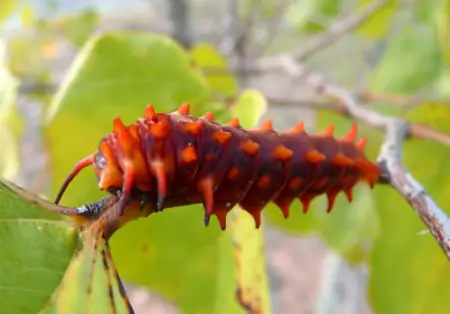
The Pipevine Swallowtail Caterpillar (Battus philenor) is usually found in woodlands, open fields, and gardens, among other places where its favourite plant, the pipevine, grows well. Their colors range from deep reddish-brown to brown, often with a hint of purple around the margins, and they can grow up to 2 inches in length.
These caterpillars only eat the leaves of birthwort and Dutchman’s pipe; after ingesting their toxic host plant, they turn poisoned themselves.
9. American Dagger Caterpillar (Acronicta americana)
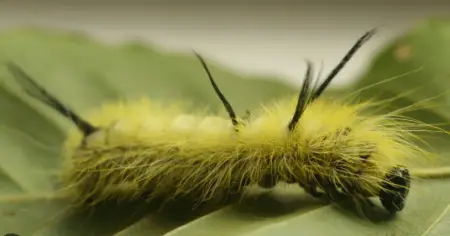
The hair of the American Dagger Caterpillar (Acronicta americana) ranges from yellow to pale green or white, giving it a fuzzy appearance. It can be identified by the four small black hair tufts on its first and third abdominal segments, as well as another one close to the end of its tail.
They are frequently seen in gardens, parks, woodlands, and backyards. They feed on the leaves of trees like alder, ash, elm, and various hardwoods. Even if they have a cute appearance, you should avoid touching them since their hairs can itch, burn, or cause skin rashes.
10. Fall Webworm Caterpillar (Hyphantria cunea)
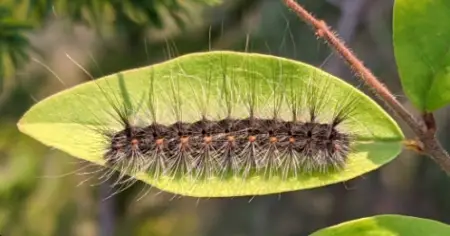
The Webworm in Autumn The common caterpillar in Georgia, Hyphantria cunea, is renowned for feasting on trees and ornamental plants. Its fluffy, bright white or yellow coloration makes the mature fall webworm moth stand out.
These caterpillars don’t pick their hosts; they feed on about ninety different kinds of leaf-shedding trees, such as crabapple, hickory, walnut, birch, and cherry. They are harmless and not a threat, even though they like to weave webs around trees. Usually, they pose less of a threat than a nuisance.
11. Yellow-Striped Oakworm Caterpillar (Anisota peigleri)
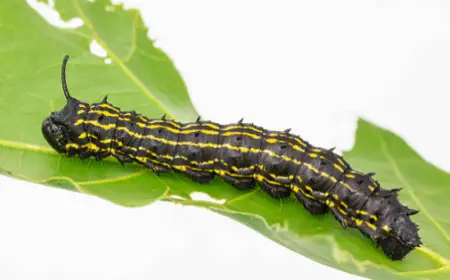
The Yellow-Striped Oakworm Caterpillar (Anisota peigleri) is a stunning black caterpillar with bright yellow stripes that can grow up to 2 inches in size. They have black extensions coming out of their second thoracic segment, and each one has a row of small spikes on it.
In the early stages, these caterpillars congregate in groups and feed mostly on the softer sections of the leaves, frequently stripping them almost completely. Mature caterpillars are safe and do not pose a hazard to people, despite their prickly appearance.
12. Pearl Crescent Caterpillar (Phyciodes tharos)
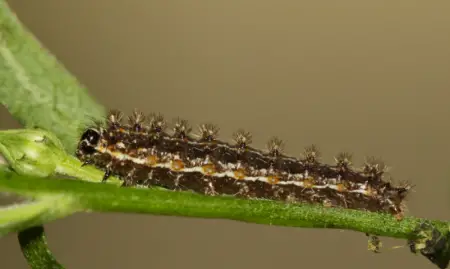
Phyciodes tharos, also known as the Pearl Crescent Caterpillar, is a fascinating sight that is frequently encountered in Georgia’s open spaces, such as parks, roadsides, and light pine forests. It has many small, branching spikes and soft cream-colored stripes on the sides that range in color from deep brown to smoky gray.
These caterpillars feed in groups in the early stages, mostly on asters. If you come upon one, don’t be alarmed; they are not toxic or dangerous.
13. Imperial Moth Caterpillar (Eacles imperialis)
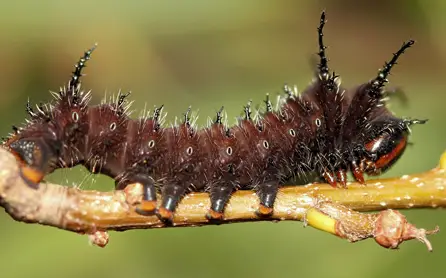
Initially appearing as little, orange creatures less than half an inch in size, the Imperial Moth Caterpillar (Eacles imperialis) is a spectacular sight. They are easily identified by their distinctive black spines. They develop into large, up to 5-inch-long caterpillars that are green, brown, or occasionally have bright orange patterns.
They have a varied diet, although they especially like to eat maple, oak, and pine trees. It is advisable to exercise caution as the venom contained in their spiky exoskeleton may sting when touched and trigger allergic responses in certain people.
14. Eastern Tent Caterpillar (Malacosoma americanum)
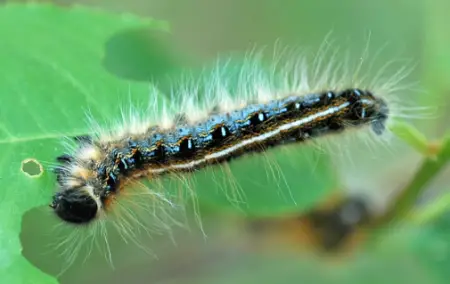
Known for their gregarious nature, Georgia’s Eastern Tent Caterpillars (Malacosoma americanum) build communal nests in their hundreds to provide warmth and food for one another. These caterpillars, which have soft bodies with sporadic tufts of hair down their sides and a distinct line running along their back, have a color combination of blue, black, and orange. When fully grown, they measure around two inches. They mostly eat the leaves of wild crabapple, apple, and cherry trees.
15. Cloudless Sulphur Caterpillar (Phoebis sennae)
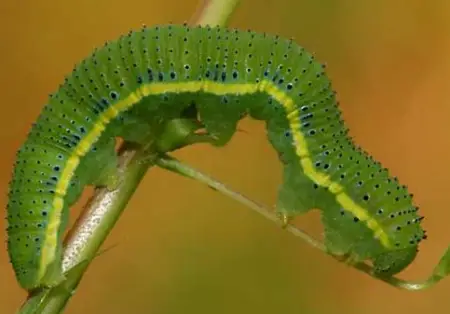
The butterfly Phoebis sennae, often known as the Cloudless Sulphur Caterpillar, has unusually angled wings. The caterpillars have a pattern of black spots down their backs and yellow or green hues with side stripes upon hatching.
They eat leaves and flowers, especially those belonging to the Cassia and Senna families. The caterpillars consume the poisons found in these plants, which makes them toxic and unappealing to potential predators.
16. Red-Spotted Admiral Caterpillar (Limenitis arthemis)
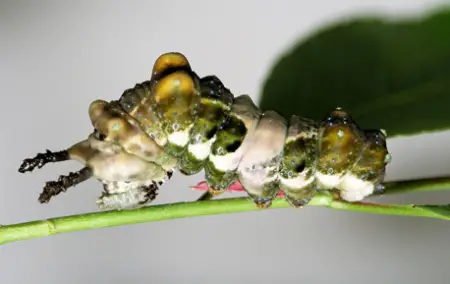
During its growing phases, the Red-Spotted Admiral Caterpillar (Limenitis arthemis) mimics bird droppings; it has two distinct thoracic horns and colors that range from green to brown with creamy patterns. Look for rounded projections close to its head rather than spikes to differentiate it from the viceroy caterpillar.
They are native to North America and mostly eat willow, poplar, and aspen trees, while some of them prefer the leaves of black cherry and yellow birch trees. This caterpillar is harmless and does not represent a threat to humans, despite its unusual look.
17. Luna Moth Caterpillar (Actias luna)
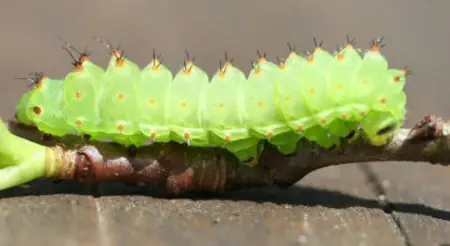
Reaching up to 4 inches in length, the Luna Moth Caterpillar (Actias luna) is also referred to as the American moon moth or a kind of huge silk moth. When it ages, its original green color gives way to magenta and yellow patches.
The moths, which mostly feed on the leaves of walnut, hickory, and pecan trees, may seem frightening due to their vivid colors, but neither they nor their caterpillars pose any threat to humans.
18. Common Buckeye Caterpillar (Junonia coenia)

The Common Buckeye Caterpillar, or Junonia coenia, is a 1.5-inch caterpillar that does best in open areas with little vegetation. Their black bodies are covered in bright patterns that are beige, gray, and white. White streaks and orange dots are added to the sides.
Buckeye caterpillars, in contrast to many others, preferring to be alone and feed mostly on weed plantains and vibrant-flowered Gerardia, as well as snapdragon, toadflax, and other native weeds. They are harmless to humans even though they have spines.
19. Gulf Fritillary Caterpillar (Dione vanillae)
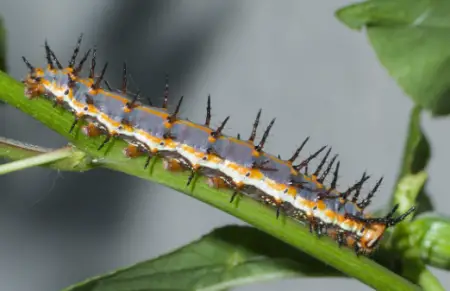
As it matures, the Gulf Fritillary Caterpillar (Dione vanillae) transforms into an eye-catching orange butterfly with long wings that is frequently connected to the passion butterfly family. The caterpillar within hatches from bright yellow eggs and becomes transparent. When the caterpillar is fully grown, it has black prickles and a vibrant orange color.
The passionflower, especially the purple kind, is their primary food source. Birds are discouraged by the repulsive aspect of the mature Gulf fritillary butterfly and its toxic larva.
20. Army Cutworm Caterpillar (Euxoa auxiliaris)
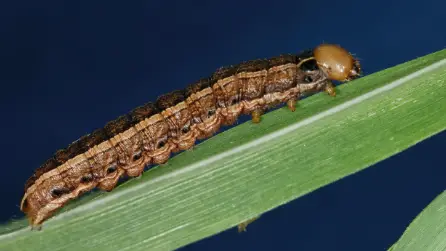
For daytime concealment, the Army Cutworm Caterpillars (Euxoa auxiliaris) weave mesh-like shelters out of the turf. When fully developed, they reach a length of 1½ to 2 inches, with hues ranging from green to black. They have darker top sides and two distinct stripes on either side, one orange and the other dark. They are harmless to people and have a diverse diet that includes grasses, wild plants, and crops.
21. Monarch Caterpillar (Danaus plexippus)
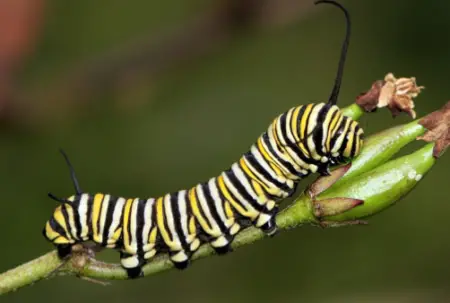
With its orange, white, and black wings, the Monarch Caterpillar (Danaus plexippus) is a well-known milkweed butterfly in Georgia. It goes through five stages in its life cycle, losing skin after each one. Depending on the temperature and availability of food, each stage lasts for around five days.
After hatching, the caterpillar has a gray-white to light green appearance. Gradually, dark stripes with little bumps forming the front tentacles appear on a green background. Its pattern shifts to include white, black, and yellow bands in the second stage. It also has a yellow triangle on its head with two yellow bands surrounding it, and its black tentacles are beginning to expand.
22. Silver-Spotted Skipper Caterpillar (Epargyreus clarus)
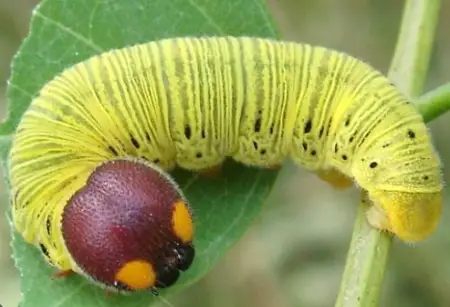
In Georgia, the Silver-spotted Skipper (Epargyreus clarus) is a commonly spotted butterfly that is typically found in fields, gardens, and the edges of forests. Its caterpillar consumes leaves from a wide range of plants, such as pea-family herbs, trees, shrubs, and vines.
These caterpillars, which may reach a length of 5 cm and have an average life span of two months, are found in wetlands and meadows. They have to contend with wasps, birds, spiders, and frogs as predators.
23. Banded Tussock Moth Caterpillar (Halysidota tessellaris)
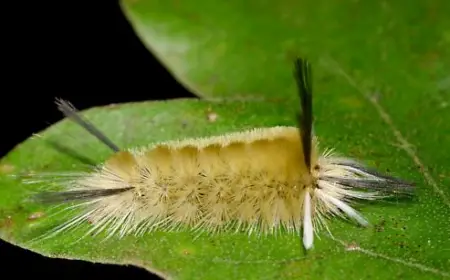
The Pale Tiger Moth, or Banded Tussock Moth (Halysidota tessellaris), was first identified in 1797. When they are caterpillars, their bodies are covered in long tufts that can be orange, yellow, or dark gray in color.
They have brilliant orange heads and long, black, white, or orange hair. These caterpillars can reach a length of 3.5 cm when they are resting on leaves. They pupate in gray cocoons with larval hairs during the winter.
Georgia’s Most Caterpillar-Heavy Regions
Georgia, known for its diverse ecosystems, experiences varying caterpillar densities across different regions. The coastal areas, including the Savannah and Brunswick regions, often exhibit high caterpillar populations due to the favorable climatic conditions and abundant vegetation. Additionally, the North Georgia mountains, encompassing areas like Helen and Blue Ridge, provide rich habitats for caterpillars, leading to significant densities in these regions. Furthermore, the central areas, such as Macon and Columbus, with their mix of urban and natural landscapes, also support notable caterpillar populations.
People Who Read This Also Read:

